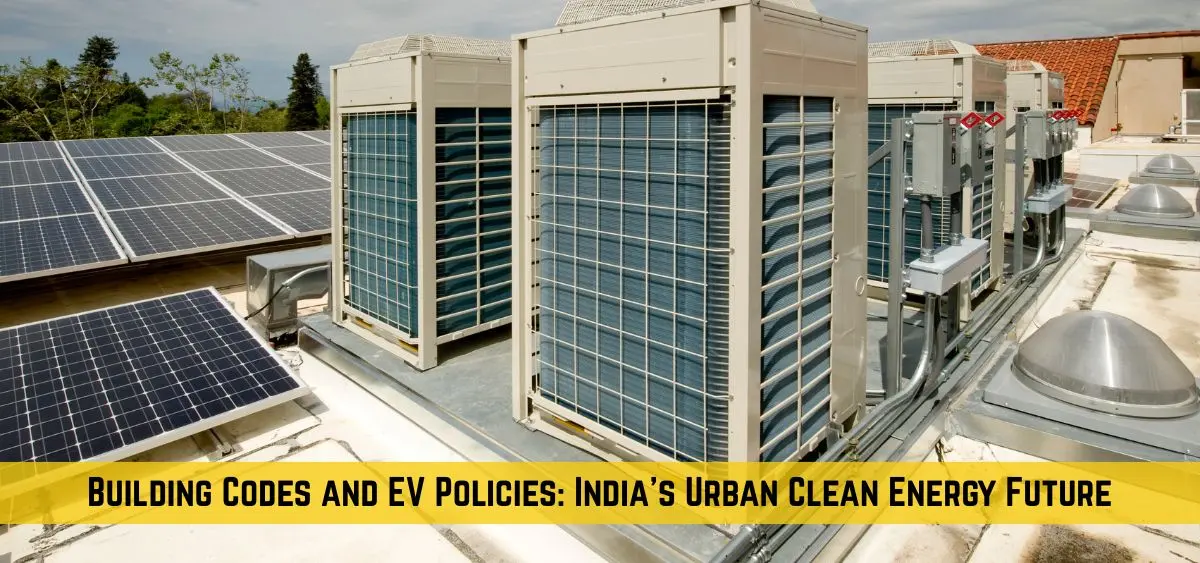Building Codes and EV Policies: India’s rapid urbanization presents both a challenge and an opportunity for clean energy transformation. According to a recent analysis by the World Resources Institute (WRI) India, cities can accelerate this shift by enforcing building energy codes and expanding support for electric mobility. The findings, shared at WRI’s Connect Karo event in New Delhi, highlight how effective building codes and EV policies together can turn cities into engines of sustainable growth.
Role of Building Codes in Energy Efficiency
The building sector is one of the largest consumers of electricity in India, with demand expected to rise steeply. To manage this growth, India introduced the Energy Conservation Building Code (ECBC) in 2007, under the Bureau of Energy Efficiency. Later, the Energy Conservation (Amendment) Act, 2022 expanded this into the Energy Conservation and Sustainable Building Code (ECSBC), setting standards for energy efficiency, renewable integration, and sustainable construction in both commercial and residential buildings.
Supporting Initiatives
- Eco-Niwas Samhita (ENS): Provides guidelines for residential energy efficiency.
- GRIHA & LEED Certification: Voluntary programs encouraging green construction.
- City-Level Action: Cities like Pune, Rajkot, Surat, and Nagpur have initiated their own measures despite state-level gaps.
Key Challenges
- Lack of city-level enforcement, even in states that notified ECBC.
- High upfront costs and low awareness about long-term savings.
- Need for streamlined coordination among departments.
Success Stories
- Chennai and Pune achieved 100% energy-efficient street lighting.
- Bengaluru (88%) and Delhi (65%) have also made major strides.
- Surat has a heat resilience plan linked with energy efficiency.
Role of EV Policies in Urban Transition
Transport is a leading cause of urban air pollution, making electric mobility a crucial pillar of clean energy. Cities like Delhi and Bengaluru are already showing progress, supported by strong national and state policies.
Key Initiatives
- FAME India Scheme: Incentives for EVs and charging stations.
- Production-Linked Incentives (PLI): Boosts domestic EV and battery manufacturing.
- Fiscal Incentives: Lower GST, customs duty exemptions, and road tax waivers.
- Policy Leadership: Delhi’s EV policy is seen as a model, with incentives, charging infrastructure, and clear targets.
Challenges Ahead
- Limited charging infrastructure is causing range anxiety.
- Heavy dependence on fossil fuels for electricity generation.
- High battery costs and reliance on imported minerals.
- Potential revenue loss from reduced fuel taxes.
- Workforce transition challenges in fossil-fuel industries.
Interconnections: Building Codes + EV Policies
India’s urban clean energy transition requires a coordinated strategy. Buildings and EVs are deeply connected—EV charging increases grid demand, while efficient buildings help reduce it. Mandating EV-ready provisions in energy-efficient buildings creates synergy, making adoption smoother and more sustainable.
Conclusion
Enforcing building codes and expanding EV policies are not isolated efforts—they are complementary pillars of India’s urban energy future. Stronger codes will curb building energy consumption, while EV policies will decarbonize transport. Together, they can reduce emissions, cut fossil fuel dependence, and help India move closer to its net-zero 2070 target. With better enforcement, central financial support, and local innovation, Indian cities can lead the clean energy revolution, improving public health and creating resilient urban spaces for generations to come.
Related Articles:-

